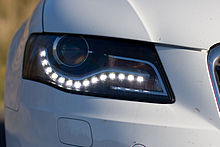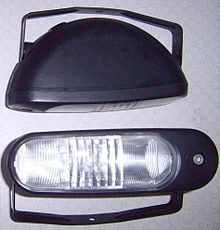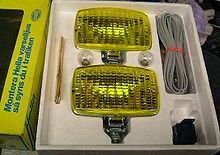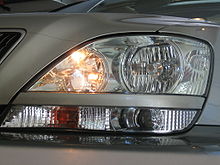- Luz de circulación diurna
-
La luz de circulación diurna (también conocida por sus siglas en inglés DRL, luz diurna o luz de día) es un componente de la iluminación automotriz que se encarga de aumentar la visibilidad del vehículo que la equipa durante su funcionamiento bajo plena luz solar, que se instala a pares en el frontal de un vehículo y que se conecta automáticamente cuando el automóvil se arranca, y que emite luz de color blanco, ámbar o amarillo selectivo. Las luces de circulación diurna podrían haber sido propuestas seriamente por primera vez en 1961 en los Estados Unidos, en respuesta a la campaña de conducción segura llevada a cabo por el gobernador de Texas Price Daniel.[1]
Contenido
Implementations
The regulations on daylight running lamps vary widely across the world. The main types of daylight running lamps in contemporary use around the world are
- low-beam headlights that illuminate when the car is started,
- dimmed high beam headlights operated at lower voltage to achieve lower intensity,
- dedicated functionally-specific lights with a defined beam pattern and light intensity,
- and the steady-burning operation of the front turn signals
Compared to any mode of headlamp operation to create the daytime running light, functionally-dedicated DRLs maximize the potential benefits in safety performance and minimize fuel consumption, glare, motorcycle masking, and other potential drawbacks.[2]
low beam headlights
 full-voltage v reduced-voltage (DRL) operation of low beam headlamp on European-market Volkswagen
full-voltage v reduced-voltage (DRL) operation of low beam headlamp on European-market Volkswagen
Low beam headlights are a common feature and have been defined for mandatory daylight running light in some countries across Europe. For a short period the UK required the low beam headlights to be also operatable at lower voltage when parking lamps ("side-lamps") are on to prevent their usage as the only vehicle indication. The usage of low beam headlights for DRLs is also called immediate headlights with some manufacturers as they are switched on immediately when the ignition circuit is activated.
Many automakers allow the operation of the low-beam headlights at reduced voltage which was originally intended for parking lamps according to street regulations in Germany. Some countries have since accepted the usage of dimmed low-beam headlights as daylight running lamps while others prohibit their usage while the car is moving as it is meant only to be used on parked cars.
dedicated daylight running lamps
Mandatory daylight running lamps were first required in Scandivian countries which soon came up with regulations for dedicated functionally-specific lamps. Consequently automakers exporting to Scandinavian countries begun to implement equipment options for their models which were also available for order in other countries. Most countries across Europe were gradually accepting dedicated daylight running lamps and many were discussing mandatory daylight running lamps for decades.
By member-state consensus the ECE R48 defines dedicated daylight running lamps which will be required for all new motor vehicles conforming to ECE R87 beginning 2011. The mandatory daylight running lamp equipment is defined to occupy an area between 25 cm² and 200 cm² and to emit light in the range of 400 ca to 1200 ca.
The ECE R87 had harmonized the installation instructions for daylight running lamps across Europe in 1995. According to section 6.19.4 DRLs shall be adjusted in the front not lower than 250 mm and not higher than 1500 mm. Minimum distance between the two DRL is 600 mm and the maximum distance to the outer frame is 400 mm. DRLs conforming to R87 must be dimmed when the low-beam headlights are activated. The certification of LED ribbon lights for retrofit kits has made installation easier as matching vents in the front spoiler can be found at most car models. In Europe only LED ribbon lights matching R87 specifications will be accepted in the regular safety inspections.
other light options
Dimmed high beam headlights allow for operation as daylight running lamps with effects in between low beam headlights and the high beam headlights at full voltage. Still they have been often criticized for being used as daylight running lamps as they increase fuel consumption and they make motorcycles not to stand out of the moving traffic anymore. The usage of fog lamps at reduced intensity or the steady-burning operation of the front turn signals is accepted only in a few countries around the world. The steady-burning operation of the front turn signals is criticized for creating an unnecessary ambiguity just as fog lamps do commonly have a high glare risk even at lower voltage due to their beam pattern. These options are illegal in European countries unless for old cars that had the feature implemented under differing regulations.
Safety performance
Numerous studies done worldwide since the 1970s have tended to conclude that daytime running lights improve safety.[2] [3] [4] However, a 2008 study by the U.S. National Highway Traffic Safety Administration analysed the effect of DRLs on frontal and side-on crashes between two vehicles and on vehicle collisions with pedestrians, cyclists, and motorcyclists. The analysis determined that DRLs offer no statistically-significant reduction in the frequency or severity of the collisions studied, except for a reduction in light trucks' and vans' involvement in two-vehicle crashes by a statistically-significant 5.7%.[5]
Effect of ambient light
The Daytime Running Light was first mandated, and safety benefits first perceived, in Scandinavian countries where it is frequently and persistently dark during daytime hours in winter time. As ambient light levels increase, the potential safety benefit decreases while the DRL intensity required for a safety improvement increases. The safety benefit produced by DRLs in relatively dark Nordic countries is roughly triple the benefit observed in relatively bright Israel and America.[2]
Effect on motorcycle safety
In many countries, every motorcycle's low beam headlamp has been wired to illuminate whenever the engine is running, either as a matter of law or of voluntary industry practice. Some motorcycling advocacy groups are concerned over the potential for reduced motorcycle conspicuity with the introduction of headlamp-based DRLs on cars and other dual-track vehicles, since it means motorcycles are no longer the only vehicles displaying headlamps during the day.[6] Some researchers have suggested that amber DRLs be reserved for use exclusively on motorcycles, in countries where amber is not presently a permissible color for DRLs on any vehicles,[7] while other research has concluded there is a safety disbenefit to two 90 mm x 520 cd DRLs on motorcycles in comparison to one 190 mm x 270 cd dipped beam headlight. The latter result suggests that DRL luminous area may have an important influence on its effectiveness.[8]
Environmental impact
 LED daytime running lights on Audi A4
LED daytime running lights on Audi A4
DRL power consumption varies widely depending on the implementation. Traditional low beam headlights consume up to 180 W - with headlamps and all parking, tail, and marker lights on the overall power consumption for lights is in the range of 150 W to 200 W. Traditional dedicated DRL systems use low-power, high-efficacy light bulbs in the range of 5 W to 21 W - that is 10 W to 42 W for both lights. Current production DRL systems based on LED lights consume 6 to 15 vatios.
International regulators, primarily in Europe, are working to balance the potential safety benefit offered by DRL with the increased fuel consumption due to their use. Because the power to run the DRLs must be produced by the engine, which in turn requires burning additional fuel, high-power DRL systems increase CO2 emissions sufficiently to affect a country's compliance with the Kyoto protocol on greenhouse gas emissions.[9] For that reason, low-power solutions are being encouraged[10] for use when and if DRLs become mandatory in ECE Regulations. LEDs and low-power, high-efficacy, long-life light bulbs produce appropriate amounts of light for an effective DRL without significantly increasing fuel consumption or emissions. Fuel consumption reductions of up to 0.5 mpg may be found when comparing a 55 W DRL system to a 200 W DRL system.[11]
In 2006, the UK's Department of Transport also found significant reductions in emissions and fuel consumption when comparing a 42 W DRL system to a 160 W full headlight DRL systems.[12] DRL fuel consumption can be reduced to insignificant levels by the use of 8 to 20 W DRL systems based on LEDs or high-efficacy filament bulbs.
The additional fuel consumption to drive normal car lights is considered to be on average around 0.2 l/100 km. With dedicated LED DRLs the fuel equivalent drops to around 0.01 l/100 km.[13]
Worldwide
European Union
Germany, Spain, France and others have encouraged or required daytime use of low-beam headlamps on certain roads at certain times of year, Ireland encourages and Bulgaria requires the use of low-beam headlights at all times during winter, Italia, Hungary and Romania require daytime running lamps outside populated areas, and Czech Republic, Estonia, Lithuania, Polonia, Slovakia and Slovenia require the use of full or reduced voltage low-beam headlights at all times. Most EU states no longer significantly disagree over whether DRLs should be required, permitted, or prohibited; by member-state consensus, from 2011, ECE R48 will require DRLs conforming to ECE R87 on all new motor vehicles.[14] [15] DRLs compliant with R87 emit white light of between 400 and 1200 candelas.[16]
DRLs were first mandated in Scandinavian countries, where ambient light levels in the winter are generally low even during the day. Sweden was the first country to require widespread DRLs in 1977. At the time, the function was known as varselljus ("perception light" or "notice light"). The initial regulations in these countries favored devices incorporating 21-vatio signal bulbs identical to those used in brake lamps and turn signals, producing yellow or white light of approximately 400 to 600 candelas on axis, mounted at the outer left and right edges of the front of the vehicle. Finland adopted a daytime-light requirement in 1972 on rural roads in wintertime, and in 1982 on rural roads in summertime and 1997 on all roads all year long; Norway in 1986, Iceland in 1988, and Denmark in 1990. To increase manufacturer flexibility in complying with the requirement for DRLs, the daytime illumination of low-beam headlights was added as an optional implementation. Given the ECE headlamp specifications in use in those countries, such an implementation would produce approximately 450 cd axially.
United Kingdom
United Kingdom national regulations[17] required vehicles first used on or after 1 April 1987 to be equipped with a dim-dip device or daytime running lamps, except such vehicles as comply fully with ECE Regulation 48 regarding installation of lighting equipment. A dim-dip device operates the low beam headlamps (also called "dipped beam" in the UK) at between 10 percent and 20 percent of normal low-beam intensity when the side lamps are switched on, the primary aim being to prevent drivers using only position lamps at night.
UK specifications for functionally-dedicated DRLs called for at least 200 candelas straight ahead, and no more than 800 candelas in any direction. These regulatory provisions were based on ILPE research and recommendations.[18] In practice, most vehicles were equipped with the dim-dip option, rather than DRLs. Subsequently,Plantilla:When the UKs Dim-Dip requirement was quashed by the European Commission. See automotive lighting for more information.
Russia
The first Russian regulation on DRL was GOST (ГОСТ Р),[19] approved in 1999 and very similar to European ECE R87.
Canadá
La Canada Motor Vehicle Safety Standard 108 obliga la instalación de DRL en todos los vehículos de nueva fabricación o importados a partir del 1 de enero de 1990. La norma canadiense propuesta sobre las luces diurnas era esencialmente similar a las existentes en Escandinavia, con un límite de intensidad lumínica axial de 1.500 candelas, pero los fabricantes se quejaron, debido a que resultaba muy caro añadir un nuevo sistema de iluminación delantero, e incrementaría los costes de la garantía el funcionar con los faros de corto alcance. Después de una batalla de normativas, se escribieron de nuevo los estándares para permitir el uso de de los faros de largo alcance con un voltaje reducido que procuzcan hasta 7.000 candelas de iluminación axial, al igual que se permitió cualquier color de luz desde el ámbar hasta el amarillo selectivo. Estos cambios en las normativas permitieron a los fabricantes implementar unas luces de circulación diurna más baratas, hechas a partir de conectar los filamentos de largo alcance en circuitos en serie para suministrar a cada uno la mitad del voltaje adecuado, o conectando los intermitentes frontales permanentemente, excepto en el momento en el que parpadean para indicar la señal de giro.
Estados Unidos
General Motors, interesada en reducir las variaciones en la construcción de los vehículos fabricados para el mercado norteamericano, empezó a presionar al DOT (United States Department of Transportation) para que permitan las DRL en los Estados Unidos poco después de que Canadá las hiciera obligatorias. Se luchó una larga batalla regulatoria, ya que el DOT estuvo objetando potenciales desventajas o inconvenientes en cuanto a términos de seguridad y deslumbramiento. De todas formas, estas objeciones fueron desechadas y las DRL del mismo tipo de las que se permiten en Canadá (excepto por las luces antiniebla diurnas) fueron legalizadas pero no obligatorias en los modelos fabricados a partir de 1995. General Motors inmediatamente equipó a la mayoría de sus modelos, y a todos en en años sucesivos, con luces de circulación diurna, empezando por el Chevrolet Corsica. Saab, Volkswagen, Volvo, Suzuki y Subaru gradualmente introdujeron las luces diurnas en el mercado estadounidense a partir de 1995. En años recientes, Lexus ha instalado faros de largo alcance o intermitentes basados en las luces de circulación diurna en algunos modelos hechos con especificaciones norteamericanas. Algunos modelos de Toyota se ofrecen con DRL como equipamiento de serie u opcional, y con un interruptor operable por el conductor. Empezando en las versiones para 2006 de sus modelos, Honda empezó a equipar sus modelos fabricados especialmente para este mercado con DRL, la mayoría con funcionamiento basado en el funcionamiento a una tensión reducida de sus faros de largo alcance.
La reacción pública hacia las luces diurnas, por regla general neutra o positiva en Canadá, es decididamente mixta en los Estados Unidos. Se han recibido miles de quejas sobre el deslumbramiento que producen las luces de circulación diurna poco después de que estas fueran permitidas, y también se han presentado quejas que declaran que el uso de DRL cuyo funcionamiento se basa en los faros comunes reducen la visibilidad de las motocicletas, y las que están basadas en los intermitentes reducen la claridad de la señal de giro. En 1997, en respuesta a estas quejas, y después de medir la intensidad de las luces diurnas reales muy por encima del límite de 7.000 cd en vehículos de calle, el DOT propuso cambios en la legislación sobre las luces de circulación diurna, cuya intensidad sería capada hasta las 1.500 candelas de intensidad axial, un nivel casi idéntico al europeo de 1.200 candelas e indéntico por completo al límite inicialmente propuesto en Canadá. Durante el periodo de toma de opiniones, miles de comentarios públicos fueron recibidos por el DOT en apoyo de la reducción de intensidad o incluso, de la completa eliminación de las carreteras estadounidenses. Las respuestas de los fabricantes fueron predecibles. Los constructores europeos, expertos en cumplir con las normas del Viejo Continente sobre estas luces, no opusieron quejas a esta proposición; los norteamericanos reiteraban las objeciones que ya presentaron en Canadá.[20] [21] La propuesta del DOT que limitaba la intensidad de las DRL fue rescindida en 2004.[22]
Australia
La luz de circulación diurna está permitida, pero no es obligatoria en Australia,[23] aunque las autoridades nacionales de la automoción están interesadas en presentarla como necesaria en un futuro.Jan 2010[cita requerida] Resulta común para los motoristas que viajan por carreteras aisladas o rurales circular con las luces de corto alcance encendidas durante el día, dado el mayor nivel de visibilidad ofrecido hacia el tráfico en sentido contrario.
Referencias
- ↑ Koornstra, Matthijs; Bijleveld, Frits; Hagenzicker, Marjan (1997). «The Safety Effects of Daytime Running Lights» (PDF). p. 3. SWOV Institute for Road Safety Research, The Netherlands. Consultado el 2007-10-05.
- ↑ a b c A Review of Daytime Running LightsPDF (1.7 MB)
- ↑ «Review of the Literature on Daytime Running Lights». Infrastructure.gov.au (16-06-2008). Consultado el 29-01-2010.
- ↑ «North American DRL studies». IIHS (01-12-1989). Consultado el 29-01-2010.
- ↑ Wang, Jing-Shiarn (September), «The Effectiveness of Daytime Running Lights for Passenger Vehicles» (PDF), NHTSA Technical Report, Washington. D.C.: National Highway Traffic Safety Administration, p. 116PDF
- ↑ European Agenda for Motorcycle SafetyPDF
- ↑ Paine, Michael; David Paine, Jack Haley, Samantha Cockfield. «Daytime Running Lights for Motorcycles» (PDF). ESV19. http://members.optusnet.com.au/carsafety/esv19_paine_mc_drl.pdf.
- ↑ Zellner, John; Nicholas Rogers, Jacques Compagne, Jan Paul Peters (September 2007). «Development of a New Methodology for Measuring the Behavioural Conspicuity of Motor Vehicles». 7th International Symposium on Automotive Lighting. Herbert Utz Verlag GmbH. pp. 249–257.
- ↑ «DRL fuel consumption calculations». Auto.howstuffworks.com. Consultado el 29-01-2010.
- ↑ FIA Brussels report on costs & benefits of various DRL implementationsUso incorrecto de la plantilla enlace roto (enlace roto disponible en Internet Archive; véase el historial y la última versión).
- ↑ US Federal Register (7 de agosto de 1998). «Notice of Proposed Rulemaking: FMVSS 108 (Daytime Running Lights)» (PDF). NHTSA, p. 57 ¶ 2. Consultado el 05-10-2007.
- ↑ Transport Research Laboratories (17 de noviembre de 2006). «Daytime Running Lights (DRL): A Review of the Reports from the European Commission» (PDF). European Commission: Transport and Road Safety. Consultado el 20-10-2007.
- ↑ Dr. Martin Rode; Hella KGaA Hueck & Co (5. November 2008). «LED Technologie im Automobil» (en alemán) (PDF). Universität Bochum. Consultado el 28. December 2009. «"Treibstoff l/100km → 100 W ~ 0,15 l/100km" + "LED-TFL 95% weniger Energieverbrauch"».
- ↑ «EU to make DRLs mandatory from 2011». Hemscott.com. Consultado el 29-01-2010.
- ↑ «AL-Automotive Lighting DRL info». Al-lighting.de. Consultado el 29-01-2010.
- ↑ «ECE Regulation 87, Revision 2» (PDF). Consultado el 29-01-2010.
- ↑ «regulations». Dastern.torque.net. Consultado el 29-01-2010.
- ↑ «ILPE research and recommendations». Dastern.torque.net. Consultado el 29-01-2010.
- ↑ Russian ГОСТ Р regulation 41.87-99
- ↑ «docket for DRL glare complaints». Regulations.gov (19-09-2009). Consultado el 29-01-2010.
- ↑ «Aborted NHTSA rulemaking to reduce DRL glare, with public complaints». Regulations.gov (19-09-2009). Consultado el 29-01-2010.
- ↑ «NHTSA docket for withdrawal of intended rulemaking to reduce DRL glare». Regulations.gov (19-09-2009). Consultado el 29-01-2010.
- ↑ «Daytime Running Lights». ACRS (23-04-2007). Consultado el 29-01-2010.
See also
- Automotive lighting
- Automobile safety
Categorías:- Iluminación
- Tecnologías del automóvil
Wikimedia foundation. 2010.





